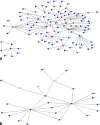A Social Network Analysis of 140 Community-Academic Partnerships for Health: Examining the Healthier Wisconsin Partnership Program
- PMID: 25974413
- PMCID: PMC4977991
- DOI: 10.1111/cts.12288
A Social Network Analysis of 140 Community-Academic Partnerships for Health: Examining the Healthier Wisconsin Partnership Program
Abstract
Introduction: Social Network Analysis (SNA) provides an important, underutilized approach to evaluating Community Academic Partnerships for Health (CAPHs). This study examines administrative data from 140 CAPHs funded by the Healthier Wisconsin Partnership Program (HWPP).
Methods: Funder data was normalized to maximize number of interconnections between funded projects and 318 non-redundant community partner organizations in a dual mode analysis, examining the period from 2003-2013.Two strategic planning periods, 2003-2008 vs. 2009-2014, allowed temporal comparison.
Results: Connectivity of the network was largely unchanged over time, with most projects and partner organizations connected to a single large component in both time periods. Inter-partner ties formed in HWPP projects were transient. Most community partners were only involved in projects during one strategic time period. Community organizations participating in both time periods were involved in significantly more projects during the first time period than partners participating in the first time period only (Cohen's d = 0.93).
Discussion: This approach represents a significant step toward using objective (non-survey) data for large clusters of health partnerships and has implications for translational science in community settings. Considerations for government, funders, and communities are offered. Examining partnerships within health priority areas, orphaned projects, and faculty ties to these networks are areas for future research.
Keywords: community engagement; community-academic partnerships for health; social network analysis; team science; translational research.
© 2015 Wiley Periodicals, Inc.
Figures




Similar articles
-
Opening the Black Box: Conceptualizing Community Engagement From 109 Community-Academic Partnership Programs.Prog Community Health Partnersh. 2016 Spring;10(1):51-61. doi: 10.1353/cpr.2016.0019. Prog Community Health Partnersh. 2016. PMID: 27018354
-
Partnership capacity for community health improvement plan implementation: findings from a social network analysis.BMC Public Health. 2016 Jul 13;16:566. doi: 10.1186/s12889-016-3194-7. BMC Public Health. 2016. PMID: 27411474 Free PMC article.
-
The Community-Academic Aging Research Network: A Pipeline for Dissemination.J Am Geriatr Soc. 2020 Jun;68(6):1325-1333. doi: 10.1111/jgs.16363. Epub 2020 Feb 10. J Am Geriatr Soc. 2020. PMID: 32039476 Free PMC article.
-
Principles of practice for academic/practice/community research partnerships.Am J Prev Med. 1999 Apr;16(3 Suppl):86-93. doi: 10.1016/s0749-3797(98)00149-4. Am J Prev Med. 1999. PMID: 10198685 Review.
-
The national improvement partnership network: state-based partnerships that improve primary care quality.Acad Pediatr. 2013 Nov-Dec;13(6 Suppl):S84-94. doi: 10.1016/j.acap.2013.04.001. Acad Pediatr. 2013. PMID: 24268091 Review.
Cited by
-
Defining and Measuring Community Engagement and Community-Engaged Research: Clinical and Translational Science Institutional Practices.Prog Community Health Partnersh. 2018;12(2):145-156. doi: 10.1353/cpr.2018.0034. Prog Community Health Partnersh. 2018. PMID: 30270224 Free PMC article.
-
Measuring quality and outcomes of research collaborations: An integrative review.J Clin Transl Sci. 2019 Oct 11;3(5):261-289. doi: 10.1017/cts.2019.402. eCollection 2019 Oct. J Clin Transl Sci. 2019. PMID: 31660251 Free PMC article.
-
Towards a practical model for community engagement: Advancing the art and science in academic health centers.J Clin Transl Sci. 2017 Oct;1(5):310-315. doi: 10.1017/cts.2017.304. Epub 2017 Dec 28. J Clin Transl Sci. 2017. PMID: 29707251 Free PMC article.
-
Analyzing mechanisms of interdisciplinary cooperation in promoting students' health at university.BMC Public Health. 2023 Oct 3;23(1):1911. doi: 10.1186/s12889-023-16786-2. BMC Public Health. 2023. PMID: 37789303 Free PMC article.
-
Promoting Students' Health at University: Key Stakeholders, Cooperation, and Network Development.Front Public Health. 2021 Jun 30;9:680714. doi: 10.3389/fpubh.2021.680714. eCollection 2021. Front Public Health. 2021. PMID: 34277547 Free PMC article.
References
-
- Haythornthwaite C. Social network analysis: an approach and technique for the study of information exchange. Libr Inf Sci Res. 1996; 18(4): 323–342.
-
- Christakis N, Fowler J. The spread of obesity in a large social network over 32 years. NEJM. 2007; 375(4): 370–379. - PubMed
-
- Aguilar‐Gaxiola S, Ahmed S, Franco Z, Kissack A, Gabriel D, Hurd T, Ziegahn L, Bates NJ, Calhoun K, Carter‐Edwards L, et al. Towards a unified taxonomy of health indicators: academic health centers and communities working together to improve population health. Acad Med. 2014; 89: 564–572. - PMC - PubMed
Publication types
MeSH terms
Grants and funding
LinkOut - more resources
Full Text Sources
Other Literature Sources
Research Materials

